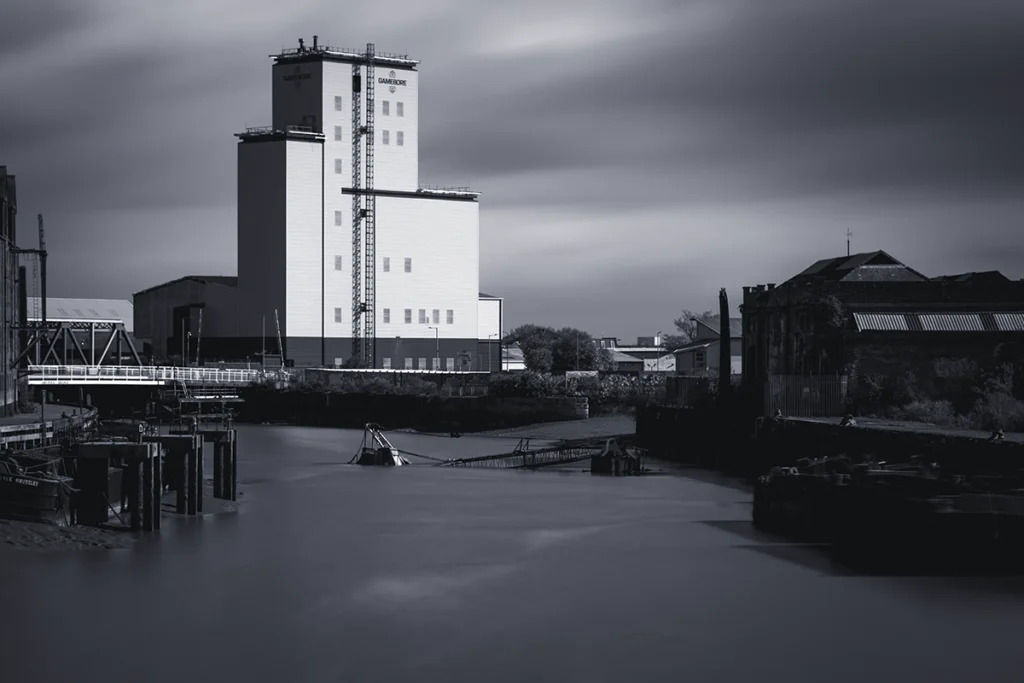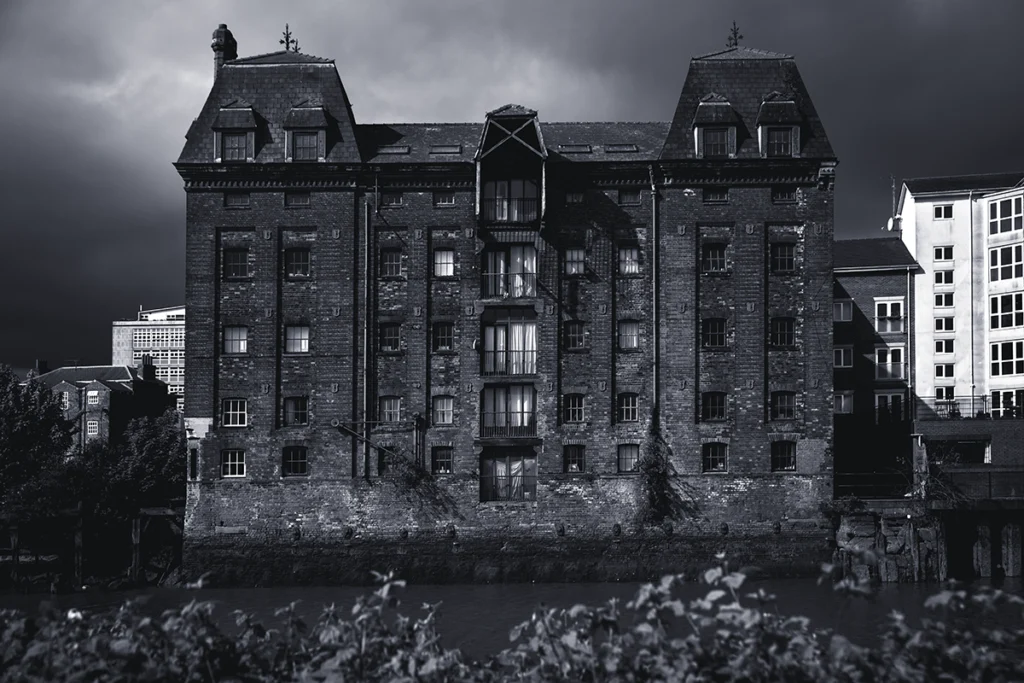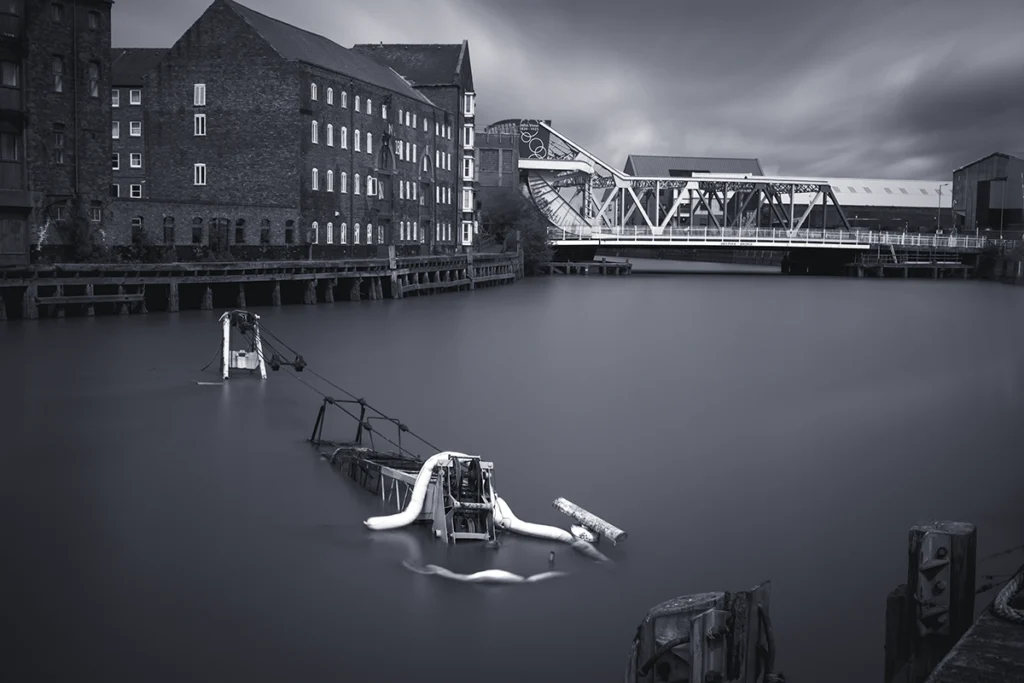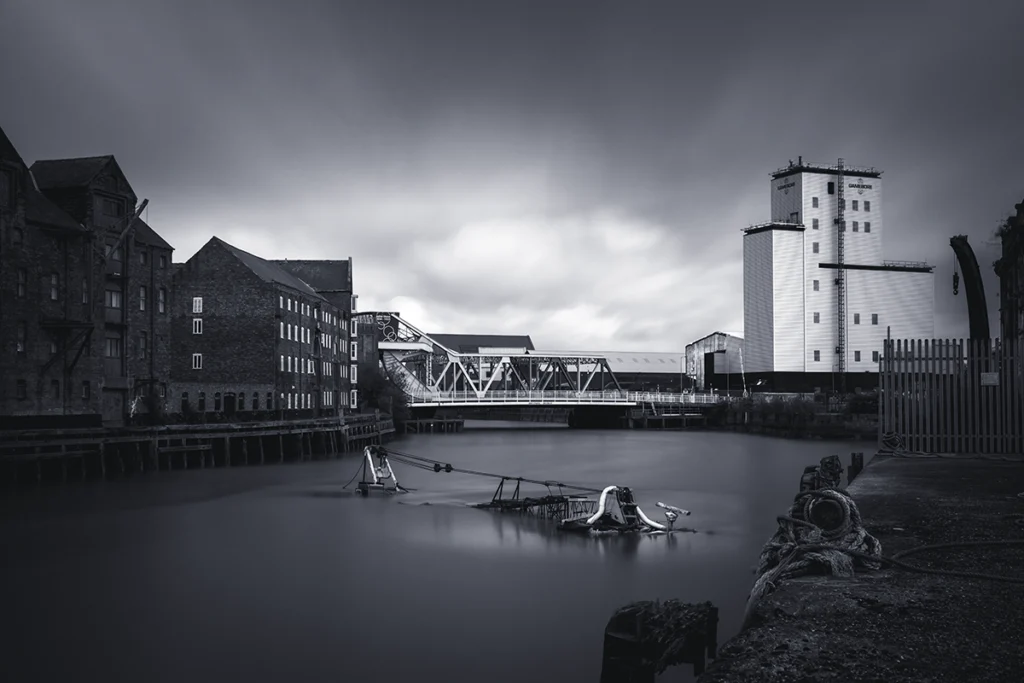When Chasing a Sinking Boats Becomes Art
The beauty of landscape photography lies not just in capturing grand vistas of mountains and moorland, but in recognising the extraordinary within the ordinary. Sometimes the most compelling images emerge from unexpected moments – like a Facebook post about industrial decay that sends you racing across Yorkshire with a car full of camera gear.
The Call of Urban Decay
I was scrolling through my feed on a grey May morning when the post appeared: a crane boat had broken free from its moorings in Hull’s marina and was slowly listing, taking on water against the backdrop of the city’s modern architecture. Most people saw a maritime mishap. I saw an opportunity.
Hull is barely an hour’s drive from my base, and the beauty of photography in urban environments is the accessibility – you can park virtually anywhere and walk to your subject. Within twenty minutes, I’d grabbed my Canon 5D Mark IV, mounted the trusty Canon EF 24-105mm f/4L USM – my workhorse lens that’s seen more adventures than I care to count – and was heading east on the M62.
Finding the Subject Within the Subject
This is where landscape photography gets interesting. The crane boat itself was the obvious subject – a piece of industrial heritage slowly succumbing to the inevitable. But the real composition lay in the relationship between decay and renewal: the listing vessel against Hull’s gleaming modern buildings, the contrast between past and future, between function and abandonment.

I’d packed my Benro Tortoise tripod and the complete Lee Filters LEE100 system, knowing I wanted to experiment with long exposure techniques. The overcast sky was perfect for extended shutter speeds, and I had a vision forming: high contrast black and white, drawing out every texture in the rusting metal while smoothing the water into silk.

Technical Choices and Creative Vision
Setting up on the marina’s edge, I composed the shot with the crane boat occupying the left third of the frame, its skeletal superstructure reaching toward the modern apartments that dominated the background. The Canon EF 24-105mm gave me the versatility I needed – zooming out to 24mm for the wide establishing shots, then pulling back to 105mm to isolate specific details of the decay.
For the long exposure, I reached for the Lee Filters Big Stopper – the 10-stop neutral density filter that would extend my shutter speed from 1/60th of a second to around 15 seconds. This would transform the gently lapping marina water into a smooth, ethereal surface that contrasted beautifully with the harsh geometry of both the decaying boat and the contemporary architecture.

I’d brought my Rab Cinder Downpour Jacket just in case, though the mild May weather made it unnecessary for most of the hour I spent fine-tuning compositions. The gentle breeze off the Humber was refreshing rather than bitter, and the conditions were perfect for dramatic imagery.

The Magic of Monochrome
Back home, processing the images in black and white revealed the true power of the composition. The high contrast treatment emphasised every rivet and rust stain on the crane boat whilst the smooth water created an almost mirror-like foundation. The modern buildings transformed into stark geometric forms that provided structure without overwhelming the primary subject.
This is the essence of finding subjects within subjects – the crane boat told one story, but the juxtaposition with Hull’s urban renewal told another entirely. The long exposure technique wasn’t just a creative choice; it was integral to the narrative, suggesting the passage of time and the inevitable march of progress.
The Broader Lesson
What struck me most about this impromptu photography session was how quickly a mundane news story became a compelling artistic opportunity. Too often, we think landscape photography requires exotic locations or perfect weather. In reality, some of the most powerful images emerge from our immediate surroundings when viewed through the right lens – both literally and metaphorically.
The sinking crane boat has since been removed from Hull’s marina, making these images a permanent record of a temporary moment. That’s perhaps the most rewarding aspect of this kind of spontaneous photography: capturing scenes that exist for mere days or weeks before disappearing forever.
Equipment Notes
For anyone inspired to chase similar urban decay subjects, the Canon 5D Mark IV paired with the 24-105mm f/4L proved ideal for this type of work. The lens’s versatility meant I could capture both wide contextual shots and tighter compositions without changing glass – essential when working alone in windy conditions. The camera’s dynamic range handled the contrast between bright sky and dark water beautifully, whilst the lens delivered consistent sharpness across the entire zoom range.
The Lee Filters system remains indispensable for long exposure work. The ability to precisely control light transmission means you can achieve exactly the shutter speed needed for your creative vision, whether that’s freezing motion or creating ethereal blur.
The Story Behind the Scene
The crane barge’s predicament wasn’t just a photographic opportunity – it represented a genuine maritime incident that had unfolded in the early hours of Friday morning. According to Hull City Council, the vessel had broken loose from its moorings and drifted across the River Hull before becoming stuck in mud between Drypool Bridge and Myton Bridge.
By the time the Maritime and Coastguard Agency teams from Humber Rescue and Cleethorpes Coastguard had responded to the initial call at 04:45 BST, the barge had partially filled with water. The weight of this water had caused it to settle on the riverbed, creating the dramatic scene I would encounter hours later.
What made this particularly compelling from a photographer’s perspective was witnessing the aftermath of this maritime drama. The harbourmaster and coastguard had already secured the scene, with tugboats standing by and precautionary booms being placed around the vessel to prevent any potential oil pollution. Fortunately, there were no reports of anyone missing or injured.
The incident highlighted Hull’s ongoing relationship with its maritime heritage and the constant challenge of managing working waterways. While authorities were formulating plans to move the barge as soon as possible, I had stumbled upon this temporary moment where industrial mishap had created an unexpectedly powerful composition.
Planning Your Own Urban Adventures
The key to successful spontaneous photography lies in always being prepared. My camera bag lives in the car boot, loaded with the essentials: body, three lenses, tripod, and filter system. When opportunity calls – whether it’s dramatic weather, breaking news, or simply interesting light – you can respond immediately.
Hull’s maritime heritage offers countless photographic opportunities, from the historic Old Town to the modern developments along the waterfront. The city’s industrial past provides rich subject matter for those willing to explore beyond the obvious tourist attractions.
Next time you see an unusual news story from your local area, consider grabbing your camera instead of just scrolling past. The most compelling photographs often emerge from the most unexpected circumstances, and the best subjects are frequently hiding in plain sight, waiting for someone to recognise their potential.
What started as a Facebook post about a maritime accident became a meditation on time, decay, and urban transformation. Sometimes the best photography happens when you simply follow your instincts and see where they lead.
P.S. When I’m not chasing sinking boats around Hull’s waterways with a bag full of camera gear, I do occasionally photograph events where people actually want to be in the pictures. If you’re planning a wedding in the Hull area and fancy a wedding photographer who knows the difference between a Big Stopper and a wedding stopper, feel free to get in touch. I promise to keep the industrial decay metaphors to a minimum during your ceremony.

